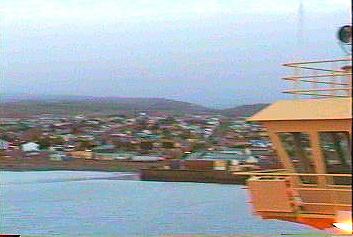12 April, 1999
Dear Friends:
I boarded the plane in a flurry. There was too much to finish to even sit
down and think about what was
happening. I was numb when I collapsed into my seat on the 11:30 PM flight
out of Miami. I happened to
be seated in front of John Prins, an engineering student from Oregon State
University, who was to assist
with keeping the sensing equipment operational. We talked for a bit then
drifted off to sleep.
I can’t get over it…Here I am, joining a team that is going to explore the
unknown waters of the Bransfield
Straits…we flew through the night, morning’s sunrays backlighting the Andes
from the air, exposing the
jagged profile which erupted from the conflict and compromise of the sea
with the earth (hasn’t it always
been that way?).
We descended to Santiago, where we met Jimmy, our Chilean representative
from Antarctic Support
Agency, who whisked us through potentially confusing lines, papers, and
delays. After a brief layover in
Santiago, we again boarded a plane and flew through Puerta Montt and then
finally on to Punta Arenas, the
last large city on the Straits of Magellan, just before the end of the
earth. For some of the team, this was
the end of over 30 hours of flying, having assembled from various corners
of the earth: a geochemist from
Paris, a biologist from New Zealand, the chief scientist and his engineers
and colleagues from Oregon, and
a European group from both France and Germany. Together they will use
cameras, dredges, temperature,
elemental analyses, and experience to locate the hydrothermal vents that
everyone hopes to find.

Punta Arenas from the top deck of the Research Vessel/Ice Breaker Nathaniel B. Palmer, looking west-southwest.
Contact the TEA in the field at
.
If you cannot connect through your browser, copy the
TEA's e-mail address in the "To:" line of
your favorite e-mail package.
|
